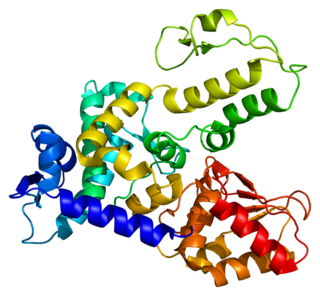
Ubiquitin-protein ligase E3A (UBE3A) also known as E6AP ubiquitin-protein ligase (E6AP) is an enzyme that in humans is encoded by the UBE3A gene. This enzyme is involved in targeting proteins for degradation within cells.

ITCH is a HECT domain E3 ubiquitin ligase that is ablated in non-agouti-lethal 18H mice. Itchy mice develop a severe immunological phenotype after birth that includes hyperplasia of lymphoid and hematopoietic cells, and stomach and lung inflammation. In humans ITCH deficiency causes altered physical growth, craniofacial morphology defects, defective muscle development, and aberrant immune system function. ITCH contains a C2 domain, proline-rich region, WW domains, HECT domain, and multiple amino acids that are phosphorylated and ubiquitinated.

Neural precursor cell expressed developmentally downregulated gene 4-like (NEDD4L) or NEDD4-2 is an enzyme of the NEDD4 family. In human the protein is encoded by the NEDD4L gene. In mouse the protein is commonly known as NEDD4-2 and the gene Nedd4-2.

E3 ubiquitin-protein ligase SMURF1 is an enzyme that in humans is encoded by the SMURF1 gene. The SMURF1 Gene encodes a protein with a size of 757 amino acids and the molecular mass of this protein is 86114 Da.

Ubiquitin-conjugating enzyme E2 D1 is a protein that in humans is encoded by the UBE2D1 gene.

Ubiquitin-conjugating enzyme E2 D2 is a protein that in humans is encoded by the UBE2D2 gene.

E3 ubiquitin-protein ligase HUWE1 is an enzyme that in humans is encoded by the HUWE1 gene.

NEDD4-like E3 ubiquitin-protein ligase WWP1 is an enzyme that in humans is encoded by the WWP1 gene.

E3 ubiquitin-protein ligase UBR5 is an enzyme that in humans is encoded by the UBR5 gene.

E3 ubiquitin-protein ligase SMURF2 is an enzyme that in humans is encoded by the SMURF2 gene which is located at chromosome 17q23.3-q24.1.

RING finger protein 11 is a protein that in humans is encoded by the RNF11 gene.

Probable E3 ubiquitin-protein ligase HERC1 is an enzyme that in humans is encoded by the HERC1 gene.

Probable E3 ubiquitin-protein ligase HERC5 is an enzyme that in humans is encoded by the HERC5 gene.

Ubiquitin-protein ligase E3C is an enzyme that in humans is encoded by the UBE3C gene.

HECT, C2 and WW domain containing E3 ubiquitin protein ligase 1 is a protein that in humans is encoded by the HECW1 gene. In human it has 1606 amino acids and isoelectric point of 5.18.

HECT domain E3 ubiquitin protein ligase 4 is a protein that in humans is encoded by the HECTD4 gene.

HECT domain and ankyrin repeat containing E3 ubiquitin protein ligase 1 is a protein that in humans is encoded by the HACE1 gene.

Ring finger protein 167 is a protein that in humans is encoded by the RNF167 gene.

RNF144A is an E3 ubiquitin ligase belonging to the RING-between RING (RBR) family of ubiquitin ligases, whose specific members have been shown to function as RING-HECT hybrid E3 ligases. RNF144A is most closely related to RNF144B at the protein level, and the two proteins together comprise a subdomain within the RBR family of proteins. The ubiquitin ligase activity of RNF144A catalyzes ubiquitin linkages at the K6-, K11- and K48- positions of ubiquitin in vitro, and is regulated by self-association through its transmembrane domain.

Ubiquitin-Protein Ligase E3B (UBE3B) is an enzyme encoded by UBE3B gene in humans. UBE3B has an N-terminal IQ motif, which mediates calcium-independent calmodulin binding and a large C-terminal catalytic HECT domain.




















